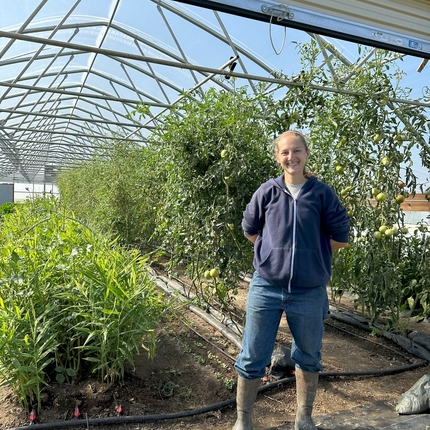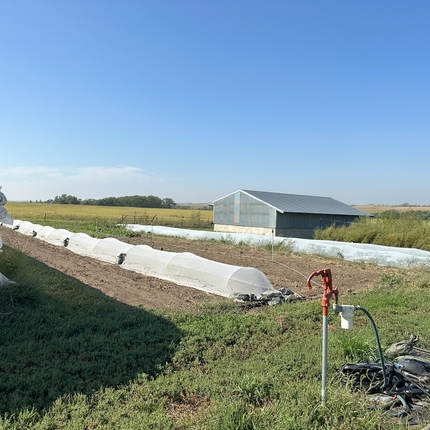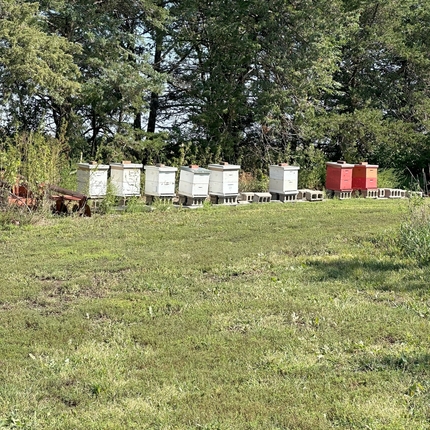Cait Caughey and Angelyn Wang contributed to this story.
When Katie Jantzen left her home state of Nebraska to attend college in Virginia, she had no idea she’d return several years later to start her own farming operation on her family’s land.
Her studies in environmental science led to an interest in local food and food systems. From there, Katie spent two years in Indiana working at a volunteer program through a church, trying to get local produce into food pantries and developing community gardens. Katie was then part of a Community Supported Agriculture (CSA) farm in Indiana before coming back to Nebraska to work on a CSA garden outside of Beatrice.
Katie’s parents ran a dairy outside of Plymouth in Jefferson County until 2010. Katie’s childhood stomping grounds are now home to her operation, West End Farm. Her dad still farms land there.
On this small, diversified, family farm, Katie operates a CSA and raises vegetables, melons, herbs, berries, and honeybees. She has 28 customers who do on-farm pickups. Katie also sells her produce at the Beatrice Farmers Market.
“Every day is an adventure on a farm, especially one in Nebraska with our challenging weather, and the complications of raising different varieties of crops,” Katie said.
She wanted to learn more about conservation practices to use with her crops and honeybees, so she applied for the Center for Rural Affairs Beginning Farmer Conservation Fellowship Program.
This initiative began in 2022 with eight individuals, plus mentors. The second cohort of the Beginning Farmer Conservation Fellowship Program started in February 2023 with eight beginning farmers, including Katie.
Conservation fellows design and implement a conservation project on their own farms or land they are farming. They present their findings at a farm tour to their mentors, project partners, and other beginning farmers.
For her project, Katie turned two pieces of land into plots to develop pollinator habitats with native species. With help from her dad, Katie cleared the plots of debris and trees, and then put down a prairie pollinator mix seed in October. The final step includes driving over the plots, then laying over jute matting material so the seed mix doesn’t blow away.
While Katie waited for brome grass to die down so she could plant, she worked with a friend who has knowledge in native plants and native seeding and of how to re-establish prairie.
“The project utilizes unused plots, and helps with my vegetable plots,” Katie said. ”I’m hoping for different things to bloom throughout the season. The two plots are different because one faces east and one faces west, but there will probably be a variety of plants that come up, just depending on the sun and the location.”
Katie’s bees are also part of her conservation project, as they need pollinator plants as well. She has eight hives this year, and previously worked with the Center on different hive style projects.
“Sometimes they work great, sometimes they don't; it's all a function of the weather,” she said. “The bees stay here over winter, and they have a windbreak. They also get wrapped up. Bees can handle cold, but they can’t handle cold and wet, just like chickens. Last year, all the hives survived. In the previous year, I lost all my hives.”
Two years ago, Katie harvested 900 pounds of honey. This year, her hives yielded just 40 pounds, possibly due to the drought.
“So far, this wild ride of farming has produced an abundance of fabulous food,” Katie said. “I'm passionate about sharing my love of food and farming with others, and I enjoy connecting with people over a great new recipe or the fantastic health benefits of fresh produce.”
Katie hopes to keep farming and plans to implement more conservation practices on her land.
“If you don’t conserve what you have, you probably won't be farming for very long,” she said. “Farmers are one of the best groups of people who can do that; they have land, they can make a bigger impact.”
The program is hosted by the Center for Rural Affairs along with project partners Nebraska Sustainable Agriculture Society, Big Muddy Urban Farm, and Metro Community College.
Learn more about Katie on our blog and in a case study.
Stay tuned for future updates on the Beginning Farmer Conservation Fellowship and mentorship opportunities. Find more at cfra.org/beginning-farmer-conservation-fellowship-program.







